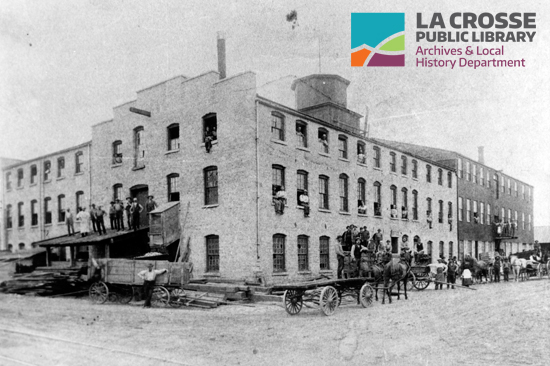History |
Segelke-Kohlhaus was a major millwork company based in La Crosse, Wisconsin. It was a successor to the Sack & Segelke firm that was founded in 1857, taking its final name in 1858 and remaining in business until 1960. The firm manufactured sash, doors, blinds, hardwood floors, stairs, stair railings, newel posts, and balustrades.
SIlas Slack and C.F. Segelke opened a carpenter shop in 1857 on the block defined by King, Front, Cass, and Second Streets. La Crosse was a major milling center along the Mississippi River in the late nineteenth and early twentieth centuries. Segelke's name was Carl F. Segelke, but he was went by Charles Segelke. Slack (whose name is also given in various documents as Stack and Sack) died in 1858 while swimming in the Mississippi River (ironically, Segelke died while fishing in the Mississippi River half a century later).
Segelke (1830-1902) needed assistance keeping the business afloat, so after Slack's death, he took in two partners. The three partners had been born in central Europe (today's Germany) and settled in Wisconsin by the mid-1850s. Jacob Kohlhaus (1829-1908) was born at Saxen Weimar; as the surviving original partner, he became president of the company. John Kutzborsky (1826-1906) was born in Prussia. He met Kohlhaus in Chicago in 1855, and they decided to move west, but Kohlhaus became sick so they stopped when they reached La Crosse. There, they met Segelke and joined his business as partners. Although the company had three partners, the name of the company was Segelke & Kohlhaus. One uncited source online states that Kutzborsky didn't join the partnership until 1869, which may explain why his name was not included the company's name. Later, the ampersand was dropped from the company name. In its early years, the firm also leased space in its building to the Moser furniture factory. A report on Segelke in 1954 stated that the early records of the company were kept in German (La Crosse Tribune, 1/3/1954).
In 1867, Segelke & Kohlhaus severed its business relationship with Moser. It constructed a three-story factory on Cross Street. This building is illustrated below. Segelke & Kohlhaus also operated a sawmill at Dancy, Wisconsin during these years, but the company sold it in 1879 when the best wood in that area had been cut.

The company's factory was enlarged again in 1886 with a three-story section for the production of molding, shingles, plate glass, and mantels. With increased demand for the company's products, the partners began plans to expand in 1897. Before construction began, however, the existing plant burned in 1898. The proposed new factory was built in 1898, greatly expanding the company's capacity. The business's campus extended from Cass Street to Cameron Avenue and from Second Street to the Mississippi River. Of this large factory complex, the only surviving building today was the office building and glazing department (today's 610 Second Street S). The 1898 factory is shown below.

The company was incorporated in 1892. Charles Segelke became president, with Kohlhaus as vice president and Kutzborsky as secretary/treasurer.
In the first decade of the twentieth century, the three founding partners died. Segelke died in 1902 while fishing on the Mississippi River, and his body was never found. Kohlhaus served as President of the firm from 1902 until he resigned due to illness in 1905. Kutzborsky then served as president from 1905 until he died in 1906.The next president was Will Ott, who served 1906 to 1949. In 1909, the company purchased a millwork plant nearby formerly operated by R.C. Kuhn Sash and Door, as Segelke was already operating at capacity and needed to expand. Even with that acquisition, Segelke built another factory addition in 1912.
Segelke was known in the early twentieth century for its method of curing lumber. By this time, the company purchased lumber and had it shipped in by rail. Workers unloaded the lumber, creating large piles for open air seasoning. Some types of lumber only needed to be seasoned six months, but harder wood needed three years. After the open air seasoning, lumber was taken to dry kilns heated by steam that eliminated any surviving moisture in the lumber. Thereupon, the lumber was taken to the company's planing department (La Crosse Tribune, 8/30/1912).
In the 1920s, the company opened branches in Milwaukee, Chicago, and Detroit. The company was so profitable at that time that it offered to build houses for employees needing them. The two known Segelke catalogs were published in 1911 and 1927.
Segelke filed for bankruptcy during the recession of 1959. Its creditors continued to operate the factory into 1960, hoping to complete existing contracts to help minimize their losses. The company's assets were auctioned in April 1960 and sold to the J.M. Kuebler Co. of Wausau for $187,050 (La Crosse Tribune, 4/15/1960). Kuebler closed the plant after one month in operation; it then auctioned the remaining millwork in 11/1960 (La Crosse Tribune, 12/2/1960). The buildings were abandoned; large sections were demolished in 1989 and then in 1995, leaving only one building standing today.
Millwork catalogs posted at archive.org: 1911 |

